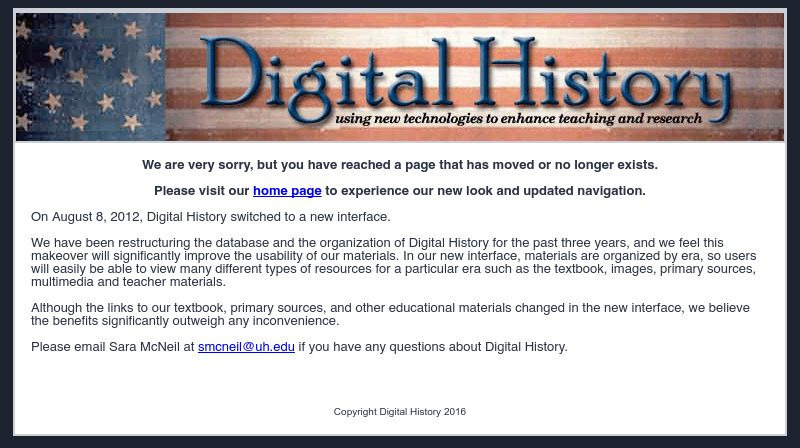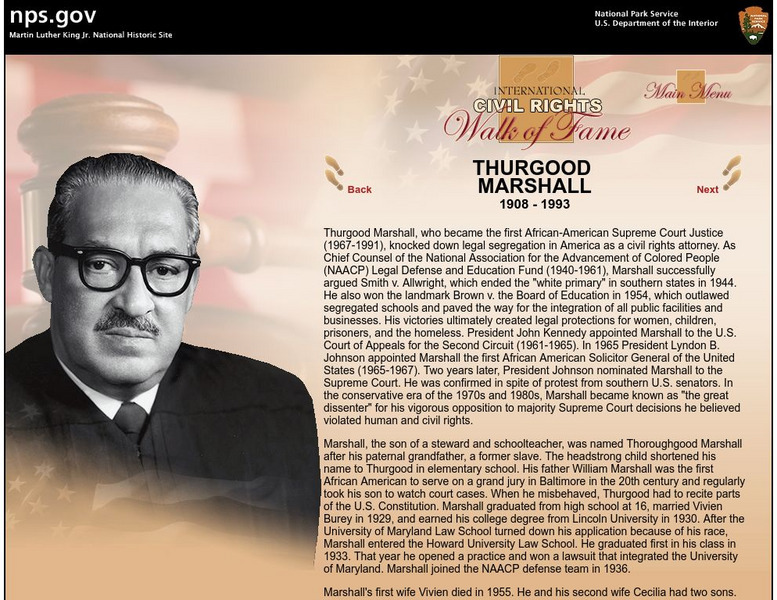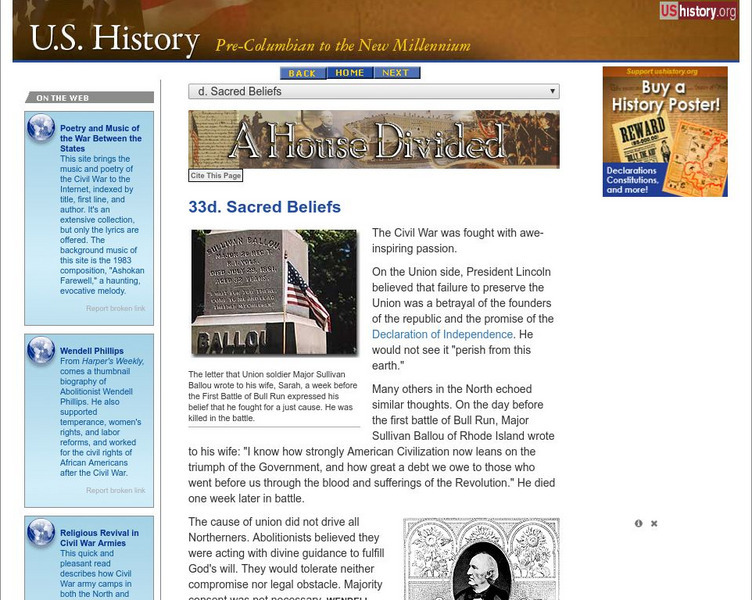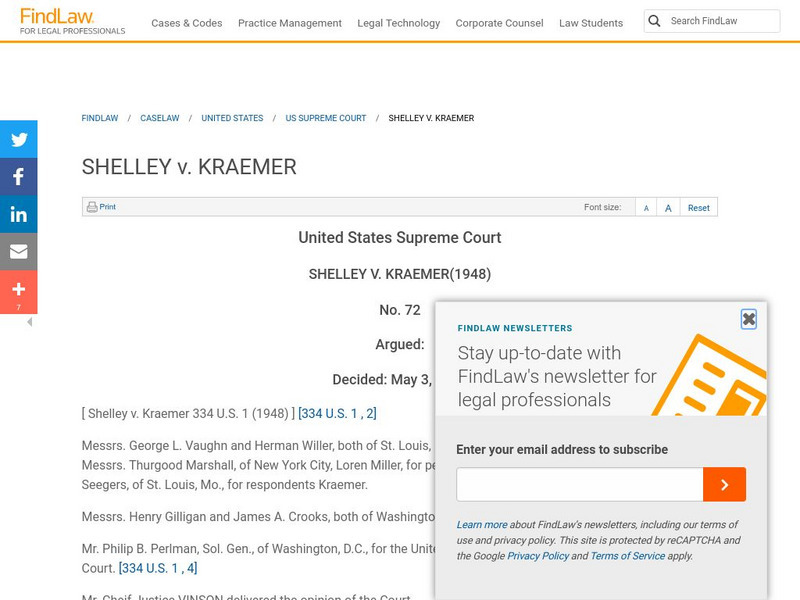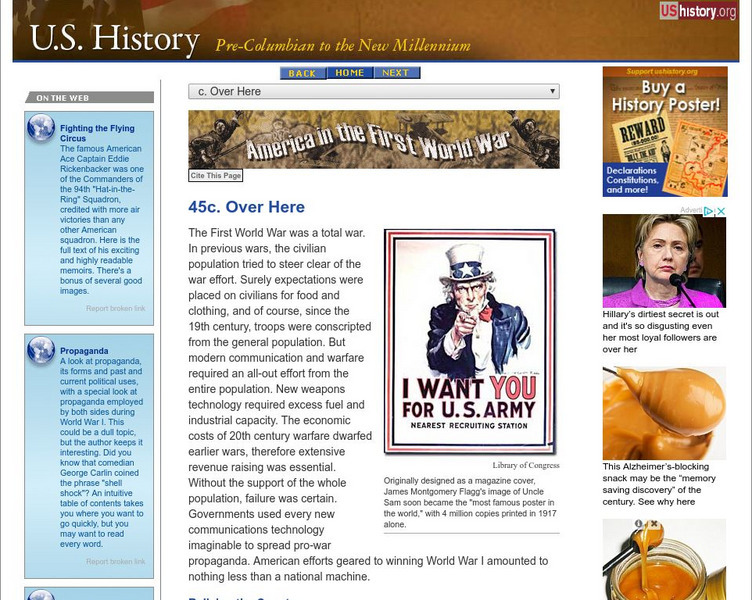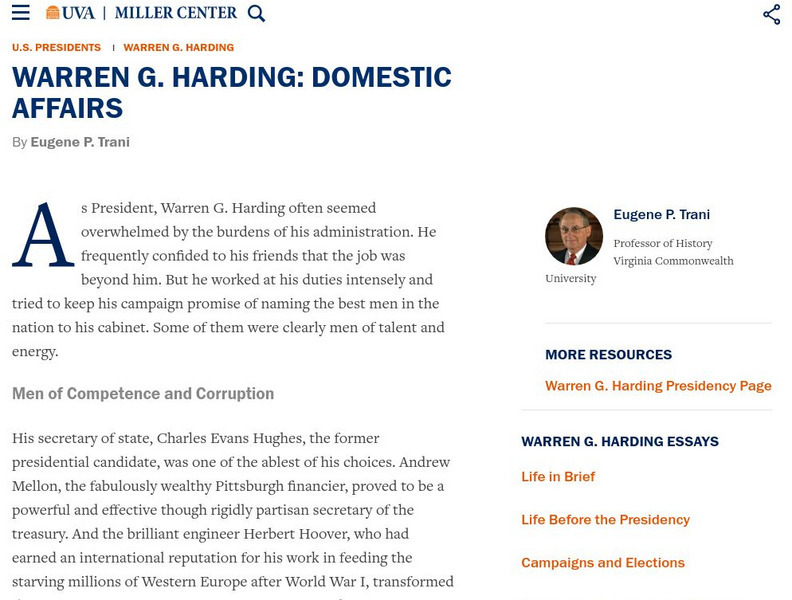National Humanities Center
National Humanities Center: Toolbox Library: u.s. Supreme Court Plessy v. Ferguson [Pdf]
Read this concise discussion of the landmark Supreme Court decision, Plessy v Ferguson. Find a synopsis of the case, the majority opinion of the court, and the dissenting opinion by Justice Harlan.
PBS
Pbs Learning Media: Affirmative Action and the Usa
In this video from Wide Angle, two American NAACP lawyers arrive to advise Brazilian civil rights organizations, leading to a discussion of differences between race relations in the U.S. and Brazil.
Digital History
Digital History: Simple Justice
Follow the civil rights quest for integrated schools from the beginning in 1849 through the 1954 Supreme Court decision in Brown v. the Topeka Board of Education and the struggle that ensued for decades following in the most reluctant...
Read Works
Read Works: Famous African Americans Martin Luther King, Jr.
[Free Registration/Login Required] This biographical sketch contains information about the Civil Rights leader, Martin Luther King, Jr. This passage is a stand-alone curricular piece that reinforces essential reading skills and...
Curated OER
National Park Service: International Civil Rights Walk of Fame: Thurgood Marshall
This is an informative biography discussing the role Thurgood Marshall had in the Civil Rights Movement, particularly as a U.S. Supreme Court Justice.
Independence Hall Association
U.s. History: w.e.b. Du Bois
Read a brief biography of W.E.B. DuBois, who was an early civil rights activist and supporter of equal opportunity and treatment for African-Americans. See how he acted on his beliefs. Included is a brief quiz about the Progressive Era.
PBS
Wnet: Thirteen: Freedom: A History of Us
Online home of the sixteen-part PBS series on American history, A History of US is a storehouse of information and resources to enrich any study of America. Includes an interactive timeline, an image browser, games, quizzes, first-person...
Independence Hall Association
U.s. History: Sacred Beliefs
At the beginning of the Civil War people in both the North and the South held firm beliefs about the reasons for the war. Some wanted to preserve the Union, others to end slavery. In the South the question was about states' rights and...
Digital History
Digital History: The Equal Rights Amendment
In 1972, Congress passed the Equal Rights Amendment (ERA) to the U.S. Constitution. The ERA subsequently failed to be ratified by the necessary number of states and was never added to the Constitution.
Thomson Reuters
Find Law: u.s. Supreme Court: Shelley v. Kraemer (1948)
The full text of the Supreme Court decision of Shelley vs. Kraemer, relating to the enforcement by the courts of private agreements that exclude persons of color.
Independence Hall Association
U.s. History: Radical Reconstruction
Read about the frustration the Radical Republicans in Congress had with the Reconstruction plans of Andrew Johnson. Find out what legislation they were able to pass over Johnson's veto, and how they attempted to protect emancipated...
Independence Hall Association
U.s. History: The Sit in Movement
Just like the Montgomery Bus Boycott, the first sit-in at a Woolworth's lunch counter was the beginning of a nonviolent movement to challenge "white only" laws. Read about how the sit-in movement spread across the South. See how...
Independence Hall Association
U.s. History: Japanese American Internment
After the Japanese attack on Pearl Harbor, fear of Japanese-Americans irrationally increased, resulting in Roosevelt's executive order that created internment camps for American citizens. Read about the camps, the life in the camps, and...
Independence Hall Association
U.s. History: Lyndon Johnson's "Great Society"
President Lyndon Johnson launched his legislation plans for his "Great Society" soon after he became president. Read about the many pieces of legislation that were passed in just a few years. See what happened to tarnish Johnson's...
Independence Hall Association
U.s. History: Kennedy's New Frontier
Read about John Kennedy's vision for America upon his becoming president. Find out about the space race with the Soviet Union, and expanded social programs for the poor and elderly in America.
Independence Hall Association
U.s. History: Separate No Longer?
An explantion of how the Supreme Court decision in Brown v Board of Education of Topeka turned the concept of separate but equal on its head. See how they determined that the 14th Amendment was being violated when schools did not fund...
Independence Hall Association
U.s. History: America in the Second World War
A brief description of the course of World War II in both Europe and the Pacific. Read about the new technologies developed for the military by both the Allies and Axis powers, and find out about the millions who died as a result of the...
Independence Hall Association
U.s. History: The Red Scare
A dark side to the Jazz Age was the increase in the fear of Communism. Read about the federal government's actions to stem anything that was thought to threaten American security.
Independence Hall Association
U.s. History: Over Here
World War I was not fought by Americans just in Europe. Read about the many ways people at home helped the war effort. See how badly German-Americans were treated as anti-German passions were fueled.
University of Virginia
Miller Center at Uva: u.s. Presidents: Warren G. Harding: Domestic Affairs
Warren G. Harding's handling of domestic affairs and the appointments made for his cabinet were a combination of good governance and terrible choice of friends. Read about his problems.
Independence Hall Association
U.s. History: The Monkey Trial
A very good look at the Scopes Monkey Trial that pit prosecuting attorney, William Jennings Bryan against defense attorney, Clarence Darrow. Read about the issues, the media circus at the trial, and eventual outcome. Find the basis of...
Encyclopedia Britannica
Encyclopedia Britannica: Whitney M. Young, Jr.
Read about the life of Whitney M. Young, Jr., U.S. civil rights leader who spearheaded the drive for equal opportunity for blacks in U.S. industry and government service during his 10 years as head of the National Urban League (1961-71).
Encyclopedia Britannica
Encyclopedia Britannica: Roy Wilkins
Read about the life of Roy Wilkins, black American civil-rights leader who served as the executive director (1955-77) of the National Association for the Advancement of Colored People (NAACP). He was often referred to as the senior...
Digital History
Digital History: September 11, 2001
This site has a comprehensive overview of the September 11, 2001 attacks on the U.S., including information on Osama bin Laden's background, the formation of Al Qaeda, the attacks themselves, the US response, civil liberties and national...


![National Humanities Center: Toolbox Library: u.s. Supreme Court Plessy v. Ferguson [Pdf] Primary National Humanities Center: Toolbox Library: u.s. Supreme Court Plessy v. Ferguson [Pdf] Primary](https://d15y2dacu3jp90.cloudfront.net/images/attachment_defaults/resource/large/FPO-knovation.png)
